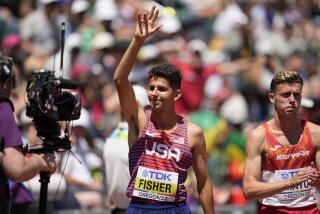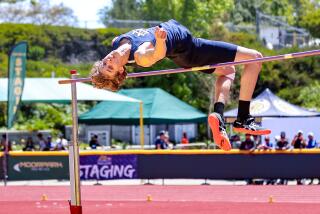Terrence Mahon Finally Steps Out From Behind Big Shadows at Oregon : Cross-Country: Heralded La Habra runner boosts the Ducks by gaining All-American honors at the NCAA championships.
- Share via
Open the media guide of the University of Oregon’s cross-country team, glance through the pages and witness the strong and storied tradition that unfolds.
Alberto Salazar . . . Rudy Chapa . . . Steve Prefontaine. The names loom from its record lists. Four national championships are among the highlights of its history; Bill Dellinger, its coach, is one of the nation’s most well-respected.
Of course, along with the guide’s look at the past, there is a look at the present. Namely the members of the current Oregon squad, with brief biographies on each.
But there is a glaring omission. His name is Terrence Mahon.
Mahon, from La Habra High School, walked on at Oregon last year as a freshman. Because his chances of making the team were so poor, he decided to redshirt. Although he competed in several meets unattached, his performances were anything but extraordinary.
He was rarely noticed. Neither Dellinger nor the Oregon runners thought he would amount to much. So when it came time for the 1989 media guide to be printed last summer, Mahon wasn’t included in the team biographies; he wasn’t among those projected as a possible team member.
Surprise, surprise.
Mahon, The Times’ Orange County runner of the year in 1987, has in one year become a great boost for Oregon. Monday, at the National Collegiate Athletic Assn. cross-country championships at Annapolis, Md., Mahon placed 18th overall--earning him All-American honors--to help the Ducks to a second-place finish. Top-ranked Iowa was first.
For Mahon, running for Oregon has been a dream come true. In high school, Mahon’s team was good but certainly not great. Because of this, he often trained on his own and raced as an individual. All the way around, it’s been a tremendous turnaround.
“He has been the surprise of the year for us,” Dellinger said. “If you were to ask me at the end of last year, I would have probably said there was no way he would make the team. I can’t think of anyone who has surprised us at Oregon as much as Terrence has.”
Surprise No. 1 came at the team’s training camp last summer. Mahon said the camp, at Odell Lake in central Oregon, gave him an opportunity to prove himself.
Mahon kept up with the top team members through most of the workouts. On the final day, the team was to run a 10-miler. Mahon stuck with one of the team’s better runners, Pat Haller, the entire distance.
“Pat was someone who was predicted to do really well for us this year, so I wanted to show that after running hard all week, I was still strong enough to stay with him,” Mahon said.
“I knew I had to run well enough to show them that I should be taken to the first meet.”
At that first meet, Mahon finished as Oregon’s No. 3 man. In the next race, he was Oregon’s second finisher. At the Pac-10 championships at Stanford, he was Oregon’s No. 3 man again, but he placed seventh overall, helping the Ducks win the conference title.
“Terrence is definitely one of the reasons we’re a better team this year,” Dellinger said.
At the NCAA Region 8 championships Nov. 11, Mahon placed fifth as Oregon swept the first five spots to win the meet with 15 points--something no other Oregon team had done at the regional meet. In that race, Mahon surged in the final quarter mile past Stanford’s Eric Mastalir, one of the nation’s finest high school runners and a California state two-mile champion while at Carmichael Jesuit in 1986.
Along with Mastalir, Mahon has outrun many of the top stars that he had met--and could not beat--in high school. They include: UCLA’s David Scudamore, a two-time Southern Section cross-country champion from Palos Verdes; Arizona’s Brian Grosso, the 1988 national cross-country champion, and UC Irvine’s Aaron Mascorro, the 1987 state two-mile runner-up at Rosemead.
Mascorro, who outkicked Mahon through two years of Southern Section competition--”in every meet we were in together,” Mahon said--finished 21 spots behind Mahon at the Region 8 meet.
When asked why he thinks he’s improved so dramatically, Mahon just shrugs. “I don’t know,” he said. “I put forth a lot of effort. It’s just steady progress. . . . Oh, and I’ve lost 20 pounds (since high school).”
Certainly, being slim and trim is important for any distance runner--Mahon is 5-feet-9 and 128 pounds and said, “If I’m 127, I can’t do a thing,”--but weight is not, in itself, a significant reason for success.
Of certain significance, for Mahon anyway, is the fact that Oregon offers a runner-happy environment. Eugene, popularly known as Track City, U.S.A., is famous for its soft, scenic wood-chip running trails--”Bark dust trails,” Mahon said--that are near inspirational for distance runners.
Also, the local population includes many world-class athletes, such as longtime resident Mary Decker Slaney and Salazar. Salazar, trying to make a comeback after several years of injury and illness, regularly trains with the Oregon squad.
Of course, rubbing elbows with running’s elite doesn’t mean the elite ability will rub off. But for Mahon, hard work has definitely made a difference. Since he arrived at Oregon last year, Mahon intensified his training program, increasing his mileage from about 50-60 miles a week as a high-schooler to around 100.
“It (the higher mileage) helps me mentally,” he said. “In a race, I wouldn’t want a guy who puts in only 50 miles a week to pass me.”
And Mahon, a strength runner who sometimes suffered from a lack of speed, has improved in that area as well. In high school, Mahon never ran the two mile faster than 9 minutes 10 seconds, but Dellinger said last week Mahon ran a 9:03 two mile in practice “as if he were jogging.”
“The best thing that helped is I worked out with (Oregon’s top two runners) Brad Hudson and Pete Fonseca this summer,” Mahon said. “Brad trains like an animal. We do most of our running at six-minute (per mile) pace. Now, running 6:30 pace feels too slow. I’m hammering myself, but not every day. I’m not stupid.”
Dellinger agreed: “He uses good common sense. That’s hard for a young runner, sometimes. There’s quite a jump between being a good runner in high school and a good runner in college.
“What impresses me most about him is the consistency he shows. We have guys who work their fannies off to make the team, much like Terrence did. They’re in great shape at first, but then later, they fall apart. He didn’t do that. He made an immediate impression with the first race, then got better each week. He’s for real.
“It goes to show you how important desire really is. A lot of people have talent but don’t do anything with it. His is to a point where his desire has taken him to where he is today.”


